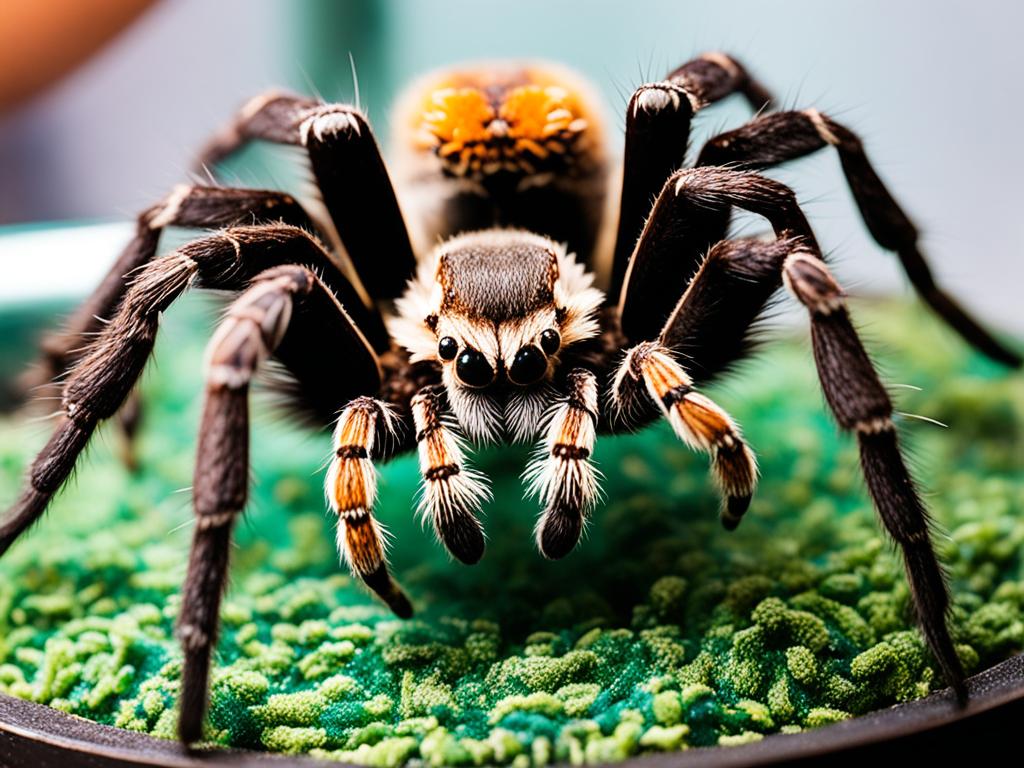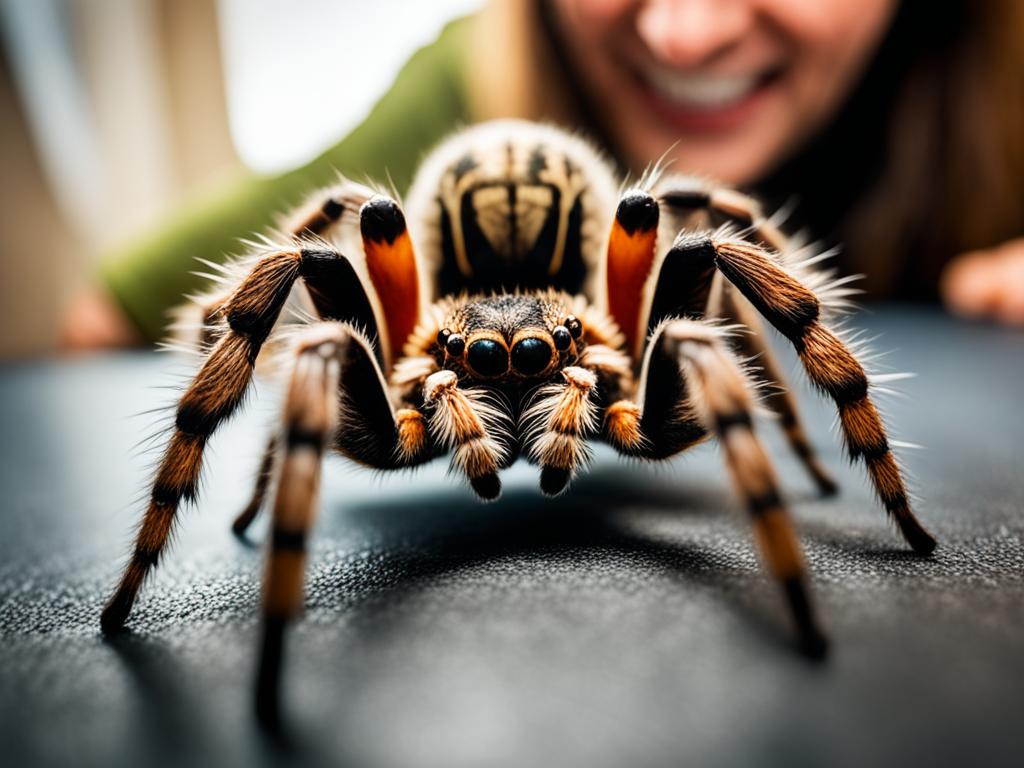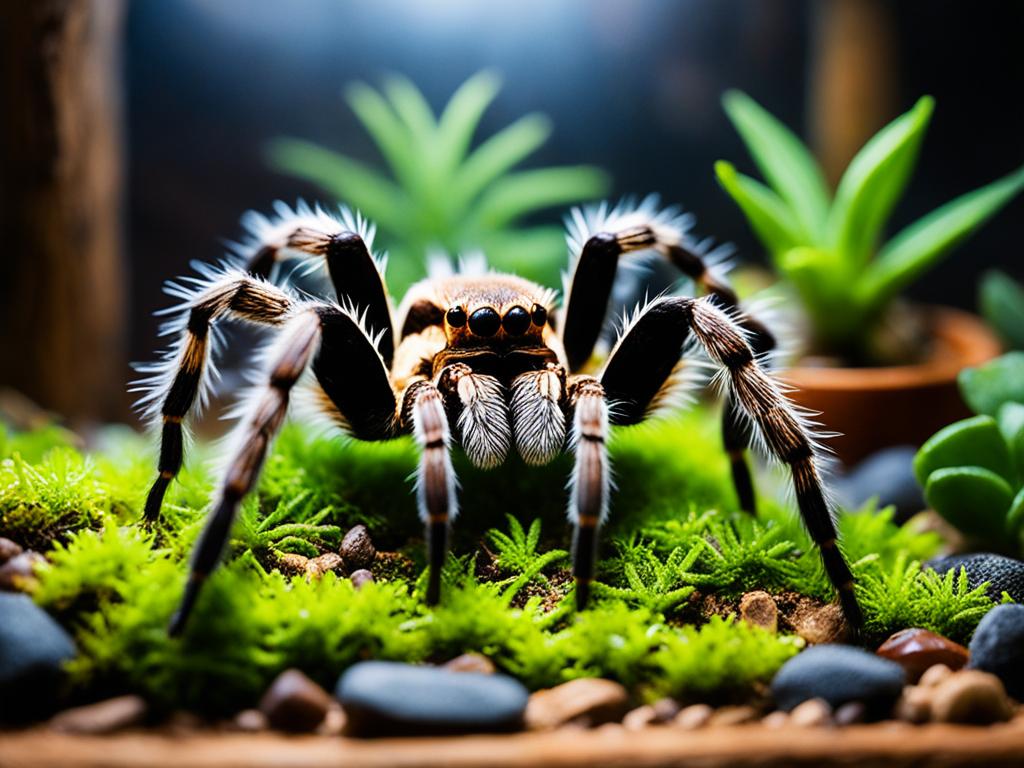Have you ever considered a tarantula as a pet? It may not be the first creature that comes to mind when thinking of a companion, but there’s more to these eight-legged wonders than meets the eye. In fact, many tarantula owners find them to be A Cool Companion that brings a unique and captivating energy into their lives.
For those curious about the Ins and Outs of Raising Tarantulas, this comprehensive guide is here to shed light on the mysterious world of tarantula ownership. Whether you’re a beginner looking for a complete Tarantula Care Guide or an experienced tarantula enthusiast seeking new Tarantula Tips, this article will provide you with valuable insights and advice.
Before we dive into the details, take a moment to imagine observing the elegant movements of a tarantula as it gracefully explores its enclosure. As its delicate legs glide over the substrate and its fangs delicately capture its prey, you realize the charm and beauty that lies within these fascinating creatures.
Are you ready to embark on a journey into the world of tarantula ownership? Let’s begin our exploration of the Tarantula Care Guide together.
Key Takeaways:
- Discover the joys of raising tarantulas as cool and captivating companions
- Gain insights into the ins and outs of tarantula care
- Find essential tips to ensure the well-being of your tarantula pet
- Learn from experienced tarantula owners about the thrills and challenges of tarantula ownership
- Cultivate a fulfilling and rewarding relationship with your eight-legged companion
Getting Started: Tarantula Care Essentials
Before bringing a tarantula into your home, it’s important to familiarize yourself with the essential care requirements. Providing the best possible care for your tarantula is crucial to its well-being and longevity as a pet. In this section, we will discuss the necessary supplies, enclosure setup, temperature and humidity control, and handling techniques to ensure the optimal care for your eight-legged companion.
Supplies for Tarantula Care
When it comes to tarantula care, having the right supplies on hand is essential. Here’s a list of must-have items for your tarantula’s well-being:
- Tarantula enclosure – Ensure it is spacious, escape-proof, and suitable for your tarantula species.
- Substrate – Choose a substrate that provides adequate moisture and is appropriate for burrowing or web-building.
- Water dish – Use a shallow dish filled with clean water for your tarantula to drink from.
- Hideouts – Provide hiding spots, such as wood or artificial shelters, where your tarantula can feel secure.
- Thermometer and hygrometer – Monitor the temperature and humidity levels to maintain optimal conditions.
- Tweezers or long-handled forceps – Use these to feed your tarantula safely.
Enclosure Setup
The proper setup of your tarantula’s enclosure is vital for its comfort and safety. Follow these guidelines:
- Choose an appropriate enclosure based on your tarantula’s size and species. Research the specific requirements for your tarantula beforehand.
- Add a suitable substrate, ensuring it is deep enough for burrowing species or provides anchor points for web-building ones.
- Place hideouts in the enclosure, allowing your tarantula ample space to retreat and feel secure.
- Provide decorations such as plants or branches to create a more natural environment.
- Position the water dish in a location where it won’t be easily tipped over and where your tarantula can access it easily.
- Ensure proper ventilation by adding small air holes or using a mesh lid.
Temperature and Humidity Control
Creating the right temperature and humidity conditions is crucial for your tarantula’s well-being. Follow these guidelines:
- Maintain the temperature within the recommended range for your tarantula species. Most tarantulas thrive between 75°F and 85°F (24°C and 29°C).
- Use a heat mat or heat lamp to regulate the temperature if necessary, ensuring it doesn’t overheat or create a temperature gradient.
- Monitor the humidity levels in the enclosure, aiming for 60% to 80% for most tarantula species.
- Mist the enclosure with water or use a humidifier to maintain the desired humidity level.
Handling Techniques
Proper handling techniques are essential for the safety of both you and your tarantula. Follow these tips:
- Always wash your hands thoroughly before and after handling your tarantula to prevent the transfer of harmful bacteria.
- Approach your tarantula calmly and gently. Avoid sudden movements or loud noises that may startle or stress your pet.
- Use a soft paintbrush or the back of your hand to encourage your tarantula to crawl onto you for short periods of handling.
- Avoid handling your tarantula during molting or when it’s in a defensive posture.
- Never handle a tarantula that you suspect may be venomous or aggressive.
By following these tarantula care essentials, you’ll be well on your way to providing a safe and optimal environment for your furry arachnid friend.
Nurturing Your Tarantula: Tips for Optimal Pet Maintenance
Now that you have created the perfect habitat for your tarantula, it’s important to understand how to properly maintain its health and happiness. Taking care of a tarantula requires attention to detail and adherence to specific pet maintenance routines. In this section, we will explore essential tips and practices to ensure your tarantula thrives under your care.
Feeding Schedules
One of the key aspects of tarantula pet maintenance is establishing a proper feeding schedule. Tarantulas are carnivorous creatures, and their diet typically consists of live insects. Schedule regular feedings, usually once a week, and offer a variety of insects such as crickets, mealworms, or roaches. Remember to remove any uneaten prey after feeding to prevent potential health issues.
Molting Cycles
Tarantulas undergo molting, a process where they shed their exoskeleton to accommodate growth. During this time, they may become more inactive and refuse food. It’s important to provide a stress-free environment and avoid disturbing them during their molting cycle. Once the molt is complete, remove the old exoskeleton from their enclosure to maintain cleanliness.
Cleaning Routines
Maintaining a clean environment is crucial for the well-being of your tarantula. Regularly remove any uneaten food, molting remnants, or waste from their enclosure. However, it’s important to strike a balance, as excessive cleaning can cause stress for your tarantula. Create a cleaning routine that ensures a hygienic habitat while minimizing disruptions to your pet.
Health Issues to Watch Out For
Being proactive about your tarantula’s health is essential to catch any potential issues early. Keep an eye out for signs of illness or injury, such as a loss of appetite, lethargy, abnormal behavior, or physical abnormalities. If you notice any concerning symptoms, consult a veterinarian who specializes in exotic pets for proper diagnosis and treatment.
Remember, tarantulas are delicate creatures that require diligent care and attention. By following these tarantula pet maintenance tips, you can provide a nurturing environment that supports your pet’s overall well-being and longevity.
| Common Health Issues | Symptoms |
|---|---|
| Dehydration | Shriveled or wrinkled appearance, dry exoskeleton |
| Mite Infestation | Itching, excessive grooming, visible mites on the tarantula |
| Respiratory Infections | Coughing, wheezing, difficulty breathing |
| Internal Parasites | Weight loss, diarrhea, decreased activity |

“Maintaining a clean and appropriate environment for tarantulas is vital for their well-being. Regular cleaning and observation of their behavior are key factors in preventing and addressing potential health issues.” – Dr. Emily Davis, Exotic Pet Veterinarian
The Thrills and Challenges: Tarantula Ownership Experiences
Tarantula ownership can be an exciting and rewarding experience, offering a fascinating glimpse into the world of these awe-inspiring creatures. However, it is essential to understand that owning a tarantula also comes with its fair share of challenges. In this section, we will explore the thrills and challenges that tarantula enthusiasts encounter, providing valuable advice to navigate this unique pet ownership journey.
Tarantula Ownership Advice from Experienced Hobbyists
Who better to seek advice from than experienced tarantula hobbyists? These passionate individuals have spent years caring for and bonding with their arachnid companions. Their insights and wisdom can help novices find their footing in the tarantula-owning world.
According to seasoned tarantula owners like Jessica Martinez, providing a secure and comfortable enclosure is paramount. “Creating a suitable habitat for your tarantula is the foundation of successful tarantula ownership. Research the specific requirements of your tarantula species and replicate their natural environment as closely as possible,” advises Martinez.
Additionally, experts stress the importance of regular observation and understanding the unique behaviors of your tarantula. “Take the time to learn about your tarantula’s habits and temperament. This will help you anticipate their needs and provide the appropriate care,” suggests David Johnson, a respected tarantula hobbyist.
Tarantula Hobbyist Tips for Overcoming Challenges
While owning a tarantula can be thrilling, there are a few common challenges that enthusiasts might encounter. With the right knowledge and strategies, you can overcome these obstacles and create a harmonious environment for your eight-legged companion. Here are some essential tips from experienced tarantula owners:
- Proper handling: Take the time to learn safe handling techniques to avoid unnecessary stress or harm to your tarantula.
- Feeding routine: Establish a consistent feeding schedule and ensure a varied diet to meet your tarantula’s nutritional needs.
- Molting cycles: Understand the molting process and create a suitable molting environment to support your tarantula during this critical phase.
- Cleaning and maintaining the enclosure: Regular cleaning of the enclosure and monitoring temperature and humidity levels are crucial for your tarantula’s well-being.
Remember, challenges are a part of any pet ownership journey, but with patience, knowledge, and dedication, you can overcome them and provide the best care for your tarantula.
Tarantula Ownership FAQ
Aspiring tarantula owners often have questions about the intricacies of tarantula care and maintenance. In this section, we address some frequently asked questions to provide a comprehensive resource for anyone considering tarantula ownership:
- How often should I feed my tarantula? Tarantulas generally require feeding once a week, but the frequency may vary depending on the species and age of your tarantula.
- Do tarantulas require special lighting? Most tarantulas do not require additional lighting. They are nocturnal creatures and prefer low-light environments.
- What temperature and humidity levels are ideal for tarantulas? Tarantulas thrive in temperatures ranging from 75°F to 85°F (24°C to 29°C) with humidity levels between 60% and 80%.
- How long do tarantulas live? Tarantulas can have varying lifespans depending on the species, ranging from 5 to 30 years.
By addressing these frequently asked questions, we hope to provide tarantula enthusiasts with the information they need to confidently care for their pet spiders.

As you embark on your tarantula ownership journey, it’s important to remember that the thrills and challenges are all part of the experience. By following the advice of experienced hobbyists, implementing effective strategies, and staying informed, you can build a strong bond with your tarantula and create a fulfilling relationship that will last for years to come.
Continue reading: Positive Environmental Stories from 2023
Conclusion
In conclusion, raising tarantulas as pets can be a truly unique and fascinating adventure for those who appreciate these incredible creatures. By understanding the ins and outs of tarantula care, following essential pet maintenance routines, and seeking advice from experienced tarantula enthusiasts, you can cultivate a fulfilling and rewarding relationship with your eight-legged companion. So go ahead, embark on this exciting journey, and welcome a tarantula into your life as a cool and captivating companion.
For more in-depth information on tarantula care, you can refer to research articles such as those published in MDPI Journal of Veterinary Sciences and PubMed Central. These resources provide valuable insights from experts in the field, offering further guidance on the nuances of tarantula ownership.
Remember, caring for a tarantula requires patience, dedication, and a strong sense of responsibility. By providing a suitable habitat, regular feeding, and proper maintenance, you can experience the joys of watching your tarantula thrive and flourish. So take the plunge, tap into your fascination for these extraordinary creatures, and embark on a journey filled with wonder and amazement.




